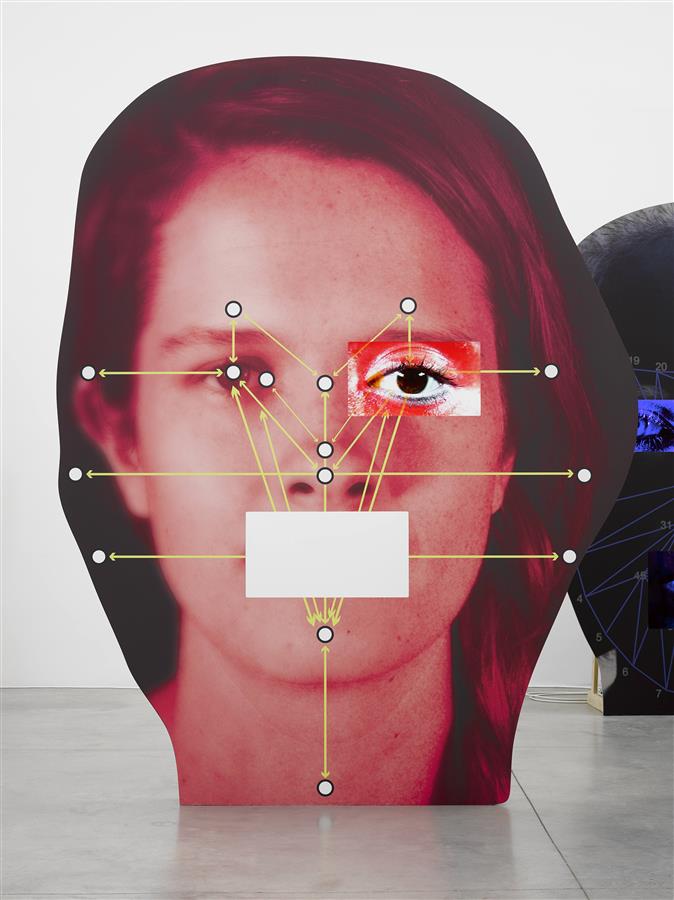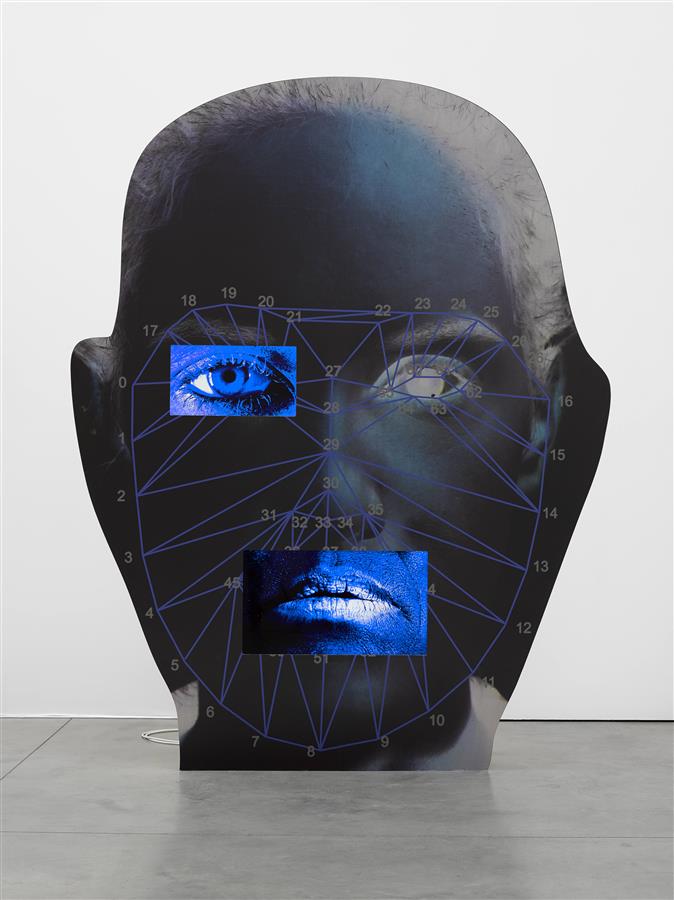
Wood, mounted photo print, monitors and media player
262 x 192 x 58 cm
The pantomime of big brother and the historical imperative to map individuality of the face for data usage comes at a time when our rights towards privacy and state sponsored collecting of data become a Orwellian theatre of the macabre, bearing rotten fruit.
By Brad Feuerhelm, ASX, February 2015
Tony Oursler’s current exhibition at Lisson Gallery, London is exacting atonement of the pandemic facial recognition patterning and physiological surveillance servitude we as society now duress under. Divergent from previous works in the artist’s oeuvre, “”template/variant/friend/stranger” focuses less on Oursler’s phantasmagoric yield (The Influence Machine, etc.) for that of technological or possibly technocratic assertions (implied). Employing similar examples of video used in the past (eyes and mouths are omnipresent), he has chosen to outfit this body of works with flat screens over that of projections. The result of which is to combine a superior technological apparatus, while also discussing the problematic discourse of its implementation over society. The pantomime of big brother and the historical imperative to map individuality of the face for data usage comes at a time when our rights towards privacy and state sponsored collecting of data become a Orwellian theatre of the macabre, bearing rotten fruit. In the large sculptural pieces, we are confronted with ley lines and sutures between points of identifiable features on human faces, which are recognized by “the machine” for its mapping of our individual and characteristic facial traits. And it is the machine if you like to call it that, which beckons us towards a sliding slope of jurisdiction over our own lives and identities.
Speaking in conversation with Guardian writer Adrian Searle, Oursler spoke in optimistic terms of what the machine can and cannot do and what we as human fodder can do to circumvent the nature of its/their (nobody seems to know who they are, the technocrats) locus’ of control and observation. Speaking on measurement systems from Alphonse Bertillon to present, the discussion was calm, hidden indoors and away from the all-seeing eye. Talk of glitter camouflage and various procedural human implements used to avert the recording of face and self were taken up humorously and at a distance, while outside the cameras whirred and hummed and perhaps made note of our collective presence.

Wood, photo print and sound
263 x 205 x 58 cm
Within this series of actions, we have assumed the reckless desire to be apart of an arrangement that advocates the questions left in the exhibition and within that, perhaps we are the greatest feeder society that is to live under and enable this advance of the technocracy, thus rendering the topic more poignant than ever.
At the end of this discussion, we are all implicit in our own need to accord data to the apparatus of distrust. No quicker had the discussion at the gallery ended than everyone reached into his/her own pocket for their hand held bug/mobile phone to check tweets and broadcast their thoughts, or perhaps text loved ones. Within this series of actions, we have assumed the reckless desire to be apart of an arrangement that advocates the questions left in the exhibition and within that, perhaps we are the greatest feeder society that is to live under and enable this advance of the technocracy, thus rendering the topic more poignant than ever. It seeps into the consciousness that we may indeed wish to be recognized and gathered. Cynicism aside, the show leaves us perhaps with more answers than questions and perhaps resistance is, indeed futile.
Tony Oursler
Lisson Gallery
Tony Oursler – template/variant/friend/stranger 30 January – 7 March 2015
(All rights reserved. Text @ Brad Feuerhelm. Images @ Tony Oursler and courtesy of Lisson Gallery.)





